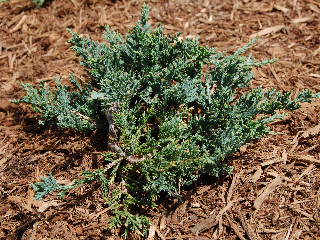
Here’s the scenario: You’re a brilliant young plant scientist working for a company whose mission is to design better and simpler products for the future.
Your boss comes in with an assignment that he thinks will throw you for a loop—use your plant breeding skills to create an ornamental landscaping specimen that is virtually maintenance free, tolerates all kinds of soils from not-very-fertile to really sandy and infertile, tolerates or even prefers dry climatic conditions, and tolerates temperatures ranging from very hot to sub-zero!
The boss smirks, thinking he’s probably given you an impossible task, and walks out buoyed by an air of superiority that he assumes he holds over a young smarty like you.
You smile gently, resisting the urge to laugh maniacally. Then you whisper under your breath, “Such a plant already exists, you old goof—it’s the blue rug juniper!”
Unable to control yourself, you run down the hall shouting out the scientific name of the plant, “Juniperus horizontalis, Juniperus horizontalis, Juniperus horizontalis……”
After being subdued by your superiors who are concerned you’re trying to entrance them with some Harry Potter spell, you’re led into a room with a single stark light bulb overhead and encouraged to “tell us the facts if you know what’s good for you…”
You spill the goods like a hot-dog push cart being run over by a bicycle messenger ……
Blurting out the facts, you begin.
“Blue rug juniper is a low-growing evergreen that’s used primarily as a groundcover. It’s perfect for rock gardens and along timber or stone borders where the trailing strands of the junipers can cascade over the walls.

“It needs full sun for sustained growth, but that’s just about all it needs. It grows in poor soils, which makes it great for planting on sandy or rocky slopes that might otherwise be unable to support vegetation or be difficult to maintain or get to with a lawn mower.
“The foliage of blue rug juniper is quite dense and somewhat “stickery” to the touch. The plants only grow about 4 to 6 inches high, but spread nicely in clumps that can be from 4 to 6 feet across—often growing into a solid ground cover mass if planted closely together. The small tight purplish cones of the blue rug junipers are often mistaken for berries.
“After planting, the young junipers can be mulched to help them hold moisture to the roots until they gain a foothold. After that, they don’t need much water or attention of any kind. If desired, you can prune out some of the runners and train others into a “rope-like” trailing growth habit over your stone walls.
“Blue rug juniper tolerates all kinds of soils, tolerates dry to almost drought-like conditions, and tolerates hot and cold temperatures. They’re virtually maintenance free.”
The single light bulb is swinging lazily back and forth, and you realize that droplets of sweat have beaded on your forehead.
Your boss stands up, looks defeatedly into your face, and mumbles as he walks out of the room, “I knew all that.”
You smile to yourself and think about where you’ll go for lunch.
 Here’s the scenario: You’re a brilliant young plant scientist working for a company whose mission is to design better and simpler products for the future.
Here’s the scenario: You’re a brilliant young plant scientist working for a company whose mission is to design better and simpler products for the future.
 “It needs full sun for sustained growth, but that’s just about all it needs. It grows in poor soils, which makes it great for planting on sandy or rocky slopes that might otherwise be unable to support vegetation or be difficult to maintain or get to with a lawn mower.
“It needs full sun for sustained growth, but that’s just about all it needs. It grows in poor soils, which makes it great for planting on sandy or rocky slopes that might otherwise be unable to support vegetation or be difficult to maintain or get to with a lawn mower.